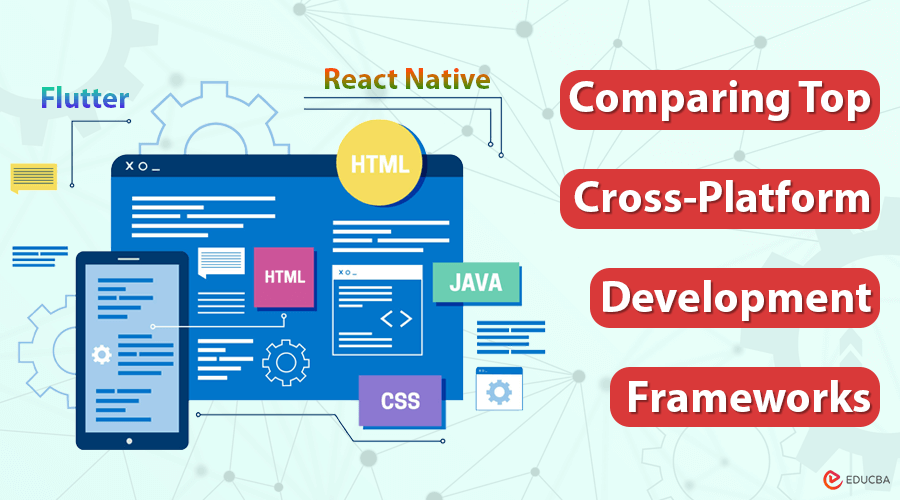
Choosing the Right Framework for Your Next App
Cross-platform development allows developers to build iOS, Android, web, and even desktop apps using a single codebase. This saves time, reduces costs, and ensures consistency across platforms. The two most popular cross-platform frameworks are Flutter and React Native. Both offer unique advantages, but choosing one over the other is crucial for companies, developers, and tech experts like ClaudeAI.Guru. The article will examine the architecture, performance, and use cases of Flutter and React Native, as well as other important factors.
What is Cross-Platform Development?
Cross-platform development involves using a single codebase to create programs that run on several operating systems. Unlike native app development, which requires separate code for iOS and Android, cross-platform frameworks streamline development, making it faster and more cost-effective.
Benefits of Cross-Platform Development:
- Faster Development: Write once, deploy everywhere.
- Cost-Effective: Reduces development and maintenance costs.
- Consistent UI/UX: Uniform experience across all platforms.
- Wider Reach: Reach both iOS and Android users with one app.
Popular Cross-Platform Development Frameworks
Here are the two most widely used cross-platform development frameworks that enable developers to build applications for multiple platforms using a single codebase.
#1. Flutter: Google’s Open-Source Framework
Google created the Flutter UI toolkit for building natively compiled applications from a single codebase. It uses the Dart programming language and provides a rich set of customizable widgets, ensuring smooth performance across all platforms.
Key Features of Flutter
- Hot Reload: This facility allows developers to see code changes instantly without restarting the app, resulting in a faster development process and higher productivity.
- Custom UI Widgets: Create a large library of pre-designed and customizable widgets. Just like DTF Printing allows for flexible, high-quality designs, our widgets let developers easily craft attractive and responsive UIs with precision and creativity.
- Super performance: property-in property. Using a Skia graphics engine ensures the UI is rendered smoothly in high frame rates, ensuring a lag-free and seamless user experience.
- One Codebase: You may develop applications targeting iOS and Android Web and desktops using just one codebase. This saves time and effort in both development and maintenance.
- Great Community Support: Flutter has Google backing it and an active attitude towards developers. Due to community contributions, this framework improves with regular updates and massive documentation.
#2. React Native: Facebook’s JavaScript Framework
The Facebook group (now Meta) created the JavaScript framework React Native to help developers create iOS and Android mobile apps. It offers developers the benefits of React.js and allows the use of native components.
Key Features of React Native
- Fast Refresh: A live reload feature for real-time UI updates.
- Reusable Components: Encourages using UI components in a reusable and modular fashion.
- Support for Third-Party Plugins: Huge ecosystem with community-maintained libraries.
- Performance Optimization: Leverages the strength of native modules to optimize performance.
- A Large Developer Community: Both the support of Meta and open-source developers.
Architecture Comparison
Flutter and React Native take different approaches to architecture but have similar effects on performance, development speed, and platform integration. Knowledge of their structure would enable developers to select the best choice for a project’s needs.
The Flutter Architecture
Fundamentally, Flutter is a layered architecture, which consists of:
- Framework Layer: Made up of UI elements/widgets and rendering.
- Engine Layer: Implemented in C++ and deals with the rendering, animation, and graphics.
- Platform Layer: Creates bridges between Flutter and the platform OS features.
Flutter applications are not based on native widgets and are less platform update-dependent.
The Architecture Of React Native
In React Native, a bridge connects JavaScript with its native counterparts:
- JavaScript Thread: The thread that facilitates all business logic running and UI updates.
- Native Modules: The JavaScript side can invoke a component written in Objective-C/Swift (iOS) or Java/Kotlin (Android).
- Bridge: The bridge provides a plane of communication in both directions. On the one hand, JS can talk to the native APIs and vice versa.
A bridge somewhat impacts performance but can interact with any native code.
Performance Comparison
Performance is the basis for deciding between Flutter and React Native. While both frameworks promise a smooth experience, the difference in architecture affects performance in terms of speed, responsiveness, and efficiency.
- Performance Measures In Flutter: Flutter compiles directly to the ARM code, enhancing performance and providing a seamless experience by eliminating a bridge. The Skia rendering engine uses smooth animation features so that the output will be at least 60 FPS. However, this causes the apps developed in Flutter to be much larger.
- Performance Measure In React Native: Most importantly, the performance bottleneck occurred in complex animations due to React Native’s dependence on the JavaScript bridge to perform animations. Performance improves with native modules combined with Hermes or a thin JavaScript engine.
Development Experience
The development experience is quite different in the programming language, debugging tools, and ease of integration with native features.
- Flutter Development Experience: Flutter developers work in Dart, a programming language that features async-await, which eases writing asynchronous code. Productivity is enhanced through features like hot reload, which instantaneously outputs any change made. Nevertheless, fewer developers are focusing on Dart than on JavaScript.
- React Native Development Experience: React Native developers apply JavaScript/TypeScript, which makes it attractive to web developers. The framework allows third-party libraries but may sometimes require manual linking, especially for native modules. Fast Refresh assists in a better debugging experience.
UI and Design Capabilities
While the frameworks have an almost comparable feature set, they differ in how they will approach design, composition, and UI customization within the framework.
- UI in Flutter: Flutter uses Material Design for Android and Cupertino for iOS, allowing it to maintain consistency across platforms. Developers can create custom widgets to fine-tune the UI design to their needs.
- UI in React Native: React Native uses native components, which provide a more natural user interface feel. However, custom UI components may require third-party libraries, leading to possible deviations from platform design guidelines.
A Quick Comparison
| Feature | Flutter | React Native |
| Language | Dart | JavaScript/TypeScript |
| Performance | High (No bridge needed) | Good (Needs optimization) |
| UI Components | Rich custom widgets | Native UI elements |
| Community | Growing but smaller | Larger due to the JavaScript base |
| Third-Party Libraries | Moderate support | Extensive ecosystem |
| Learning Curve | Moderate (Dart learning required) | Easier (JavaScript-based) |
Choosing the Right Cross-Platform Framework
If your goal is high performance and a consistent UI across platforms, Flutter is a great choice. However, if you prefer JavaScript-based development and want seamless integration with native modules, React Native is the better option.
Choose Flutter If:
- You need high-performance, graphic-intensive apps (e.g., gaming, fintech).
- You want consistent UI across platforms.
- You plan to target web, mobile, and desktop.
- You prefer Google’s ecosystem (Firebase, Android support).
Choose React Native If:
- You have experience with JavaScript/React.js.
- You need quick development with third-party libraries.
- You want to integrate with an existing native app.
- You prefer a larger developer community and more third-party support.
Future Trends
Both Flutter and React Native are continually evolving, driving innovation in the future of cross-platform mobile app development.
Key Trends to Watch:
- Flutter 3.0: Improved support for desktop and web applications.
- React Native Fabric: New architecture to reduce JavaScript bridge overhead.
- AI-Powered Development: Smarter AI-driven development tools for code optimization.
Final Thoughts
Cross-platform development offers an efficient, cost-effective way to build applications for multiple platforms. Flutter excels in performance, UI customization, and scalability, while developers prefer React Native for JavaScript-based projects, quick development, and a native feel. Choosing the right framework depends on your project’s requirements, team expertise, and long-term goals. As both Flutter and React Native continue to evolve, they will shape the future of cross-platform development.
Author Bio
Divyesh Bhatasana is the founder of Jeenam, a B2B SaaS link-building agency dedicated to helping SaaS brands grow through top-notch SEO and link-building strategies.
Recommended Articles
We hope this guide on cross-platform development helps you streamline your app creation process. Check out these recommended articles for more insights on building efficient and scalable applications.


